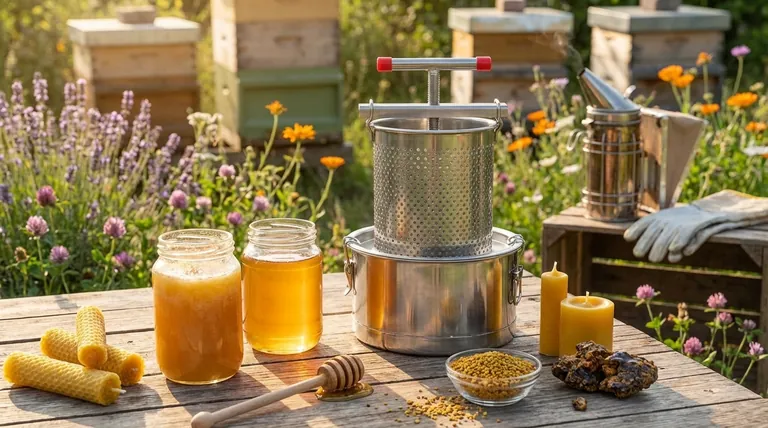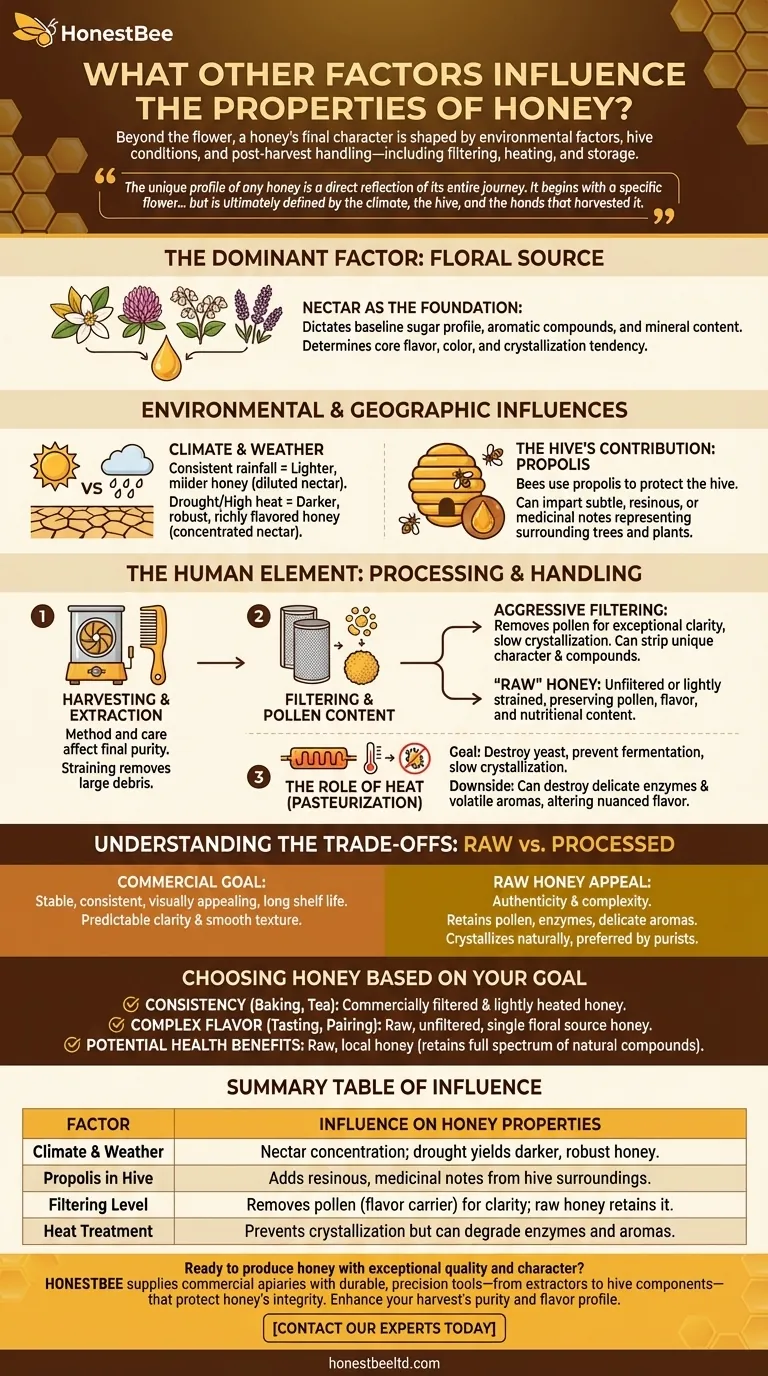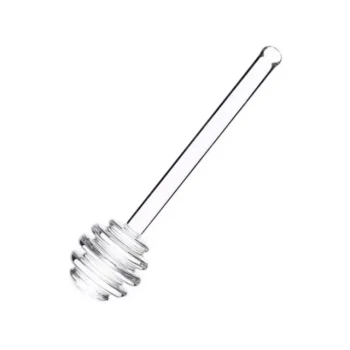Beyond the flower, a honey's final character is shaped by a host of environmental factors and human decisions. While the nectar source is paramount, the specific climate, hive conditions, and post-harvest handling—including filtering, heating, and storage methods—all play a critical role in determining the taste, color, and texture of the honey in your jar.
The unique profile of any honey is a direct reflection of its entire journey. It begins with a specific flower in a specific location but is ultimately defined by the climate it grew in, the hive it matured in, and the hands that harvested it.

The Dominant Factor: Floral Source
Nectar as the Foundation
The single greatest influence on a honey's properties is the type of nectar collected by the bees. The chemical composition of nectar from an orange blossom is fundamentally different from that of clover, buckwheat, or lavender.
This nectar dictates the baseline sugar profile (fructose vs. glucose), the presence of specific aromatic compounds, and the mineral content, which together establish the honey's core flavor, color, and tendency to crystallize.
Environmental & Geographic Influences
Climate and Weather Conditions
The weather during a nectar flow has a profound impact. Consistent, light rainfall can lead to abundant, but sometimes diluted, nectar, resulting in a lighter, milder honey.
Conversely, a period of drought or high heat can concentrate the sugars and minerals in the nectar. This often produces a darker, more robust, and richly flavored honey.
The Hive's Own Contribution: Propolis
Bees use a resinous substance called propolis to seal and protect the hive. Small particles of propolis can sometimes become incorporated into the honey.
This can impart subtle, unique notes that are often described as resinous or even medicinal, adding another layer of complexity that reflects the specific trees and plants surrounding the hive.
The Human Element: Processing & Handling
Harvesting and Extraction Methods
The choices a beekeeper makes are just as critical as nature's influence. Honey is extracted from the comb, typically using a centrifuge. How this is done—and how carefully—affects the final purity.
After extraction, the honey is usually strained to remove large debris like wax particles and bee parts. The degree of straining is a key decision point.
Filtering and Pollen Content
More aggressive filtering pushes honey under pressure through very fine filters. This process removes pollen grains and other microscopic particles, creating a product that is exceptionally clear and slow to crystallize.
However, pollen is a carrier of flavor and a key indicator of the honey's floral origin. Removing it can strip the honey of some of its unique character and nutritional compounds. "Raw" honey is typically unfiltered or only lightly strained, preserving this pollen content.
The Role of Heat (Pasteurization)
Commercial honey is often heated in a process similar to pasteurization. The primary goal is to destroy yeast cells, which prevents fermentation, and to dissolve sugar crystals, which significantly slows down crystallization.
The downside is that heat can destroy delicate enzymes and volatile aromatic compounds, fundamentally altering the honey's nuanced flavor and aroma profile.
Understanding the Trade-offs: Raw vs. Processed
The Goal of Commercial Processing
The goal of filtering and heating is to create a stable, consistent, and visually appealing product with a long shelf life. For many consumers and culinary applications, this predictable clarity and smooth texture is desirable.
The Appeal of Raw Honey
The appeal of raw, minimally-handled honey lies in its authenticity and complexity. It retains the pollen, enzymes, and delicate aromas from its source. While it will crystallize faster, this is a natural process that preserves its integrity and is preferred by many purists.
Choosing Honey Based on Your Goal
Your "best" choice of honey depends entirely on your priority.
- If your primary focus is consistency for baking or a smooth liquid for tea: A commercially filtered and lightly heated honey offers predictable performance and will not crystallize quickly.
- If your primary focus is complex flavor for tasting and pairing: A raw, unfiltered honey from a single floral source will provide the most authentic and nuanced expression of that plant and region.
- If your primary focus is potential health benefits: A raw, local honey is your best choice, as it retains the full spectrum of natural enzymes, pollen, and compounds without degradation from heat.
Ultimately, understanding these factors empowers you to appreciate the story behind every single jar.
Summary Table:
| Factor | Influence on Honey Properties |
|---|---|
| Floral Source | Determines sugar profile, flavor, and color (e.g., orange blossom vs. clover). |
| Climate & Weather | Affects nectar concentration; drought yields darker, robust honey. |
| Propolis in Hive | Adds resinous, medicinal notes from hive surroundings. |
| Filtering Level | Removes pollen (flavor carrier) for clarity; raw honey retains it. |
| Heat Treatment | Prevents crystallization but can degrade enzymes and aromas. |
Ready to produce honey with exceptional quality and character? The journey from hive to jar relies on superior beekeeping equipment. At HONESTBEE, we supply commercial apiaries and distributors with durable, precision tools—from extractors to hive components—that protect honey's integrity. Enhance your harvest's purity and flavor profile. Contact our experts today to discuss wholesale solutions tailored to your operation.
Visual Guide

Related Products
- Stainless Steel Honey Press Wax Press with Tank
- Stainless Steel Manual Honey Press with Guard for Pressing Honey and Wax
- Honey Wax Separating Wax Press with Metal Screw Wax Separator Machine
- Inverted Squeezable Honey Jar with No Drip Flip Top Cap for Easy Pouring
- Modern Honeycomb Pattern Wooden Honey Dipper for Stirring and Drizzling
People Also Ask
- What are the uses of honey in various industries? Unlock Its Functional Power in Food, Pharma & Cosmetics
- How does the press method for extracting honey work? A Simple, Low-Cost Guide for Beekeepers
- How do you press honey out of a comb? A Simple Guide to the Crush and Strain Method
- How does pressed honey compare to extracted or crush-and-strain? Unlock the Full Flavor of the Hive
- What happens to the wax after pressing in a honey press? A Guide to Maximizing Your Hive's Yield



















